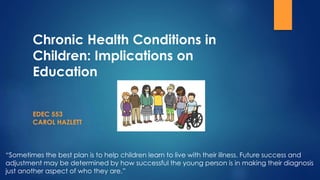
Chronic Health Conditions in Children and Education Final One
- 1. Chronic Health Conditions in Children: Implications on Education EDEC 553 CAROL HAZLETT “Sometimes the best plan is to help children learn to live with their illness. Future success and adjustment may be determined by how successful the young person is in making their diagnosis just another aspect of who they are.”
- 2. Chronic Health Conditions are illnesses that last longer than three months and impede with day to day quality of life. Asthma Diabetes Cerebral Palsy Cystic Fibrosis Cancer Severe Allergies Epilepsy Spina Bifida Heart Problems Lupus Leukemia AIDS
- 3. Overview & Prevalence In the past 20 years children with chronic medical conditions has increased from approximately 7% to about 20% in the United States. About 12 million children in the United States is affected by a chronic medical condition. Asthma, severe allergies, and diabetes are at the top of the list with obesity and related conditions at a close fourth. Chronic illnesses have genetic components, but the environment, nutrition, and activity level can play a role (i.e.: asthma, allergies, obesity, sometimes diabetes).
- 4. Impacts on Children and Family Children and families have to come to terms with a diagnosis. Families might have to provide accommodations at home (routine or physical environment). Children may experience pain or exhaustion as well as a wide range of emotions such as; fear, anger, sadness, loneliness, and confusion. Divorce is slightly more prevalent in families with chronically ill children. Siblings can sometimes feel left out.
- 5. Provide your child with age appropriate information about their illness. When possible, plan ahead for medical procedures. Children with medical illnesses can feel a loss of control, so give choices. Encourage children to spend time with their friends. Talk to your child about their emotions, and listen to what they have to say. Teach positive coping skills. Focus on your child’s strengths, in what they can do. Some children don’t like being pampered. As parents, take care of yourself as well. Utilize Services: respite care, counseling, seek out information, etc. Tips for Parents/Caregivers
- 6. Young children may not understand why they are sick, or may think it is a punishment for being bad. Preteens may go through a time when they’re angry at the parents or doctors for there not being a cure. Teenagers can become frustrated because they might be dependent on their family, but also want to become independent. Impact on Children in Stages
- 7. Many parents fear that the school won’t be able to provide for their child’s medical needs, but staff and resources are there to help. Socially, some kids don’t form close friendships because they don’t see peers. Medical conditions that are physically noticeable may be a source of bullying. A child who has a chronic medical condition may be at a higher risk for developing emotional problems which can result in behavior problems in class. Excess worry or anxiety might result in a child struggling to concentrate or remember information. Chronic absenteeism is a major hurdle that can impact education. If a child is unable to return to school there are other methods of education. (Link) Implications on Education
- 8. Communication is key when a child returns to school after a long time away. The hospital educator, the child’s doctor and nurse, the school psychologist or social worker and the child’s teacher are all there to help. Try to focus on the positives of going back to school, but also address any concerns your child may have. Returning to School: Tips for Parents
- 9. IEP versus 504 Individual Education Plans (IEP’s) are in place for children with special needs, often times they benefit from a modified curriculum. Children with chronic illnesses however, can use a 504 plan. A 504 plan means that the child is able to use the regular curriculum, but needs to be able to access the full curriculum ahead of time. 504 if a Civil Rights law under the American with Disabilities Act.
- 10. Tips for Educators Provide a positive educational environment for each child. Work together with families, the school nurse, and your principal to plan ahead for physical needs and medications. Ensure that required health forms are complete and accessible by parents, the school nurse, and teachers. Once things are planned for, remember you’re the child’s teacher, so focus on the student’s education. Some parents and children might encourage the class to be educated on the illness, typically the school nurse can help with that. A message for Teachers (Link)
- 11. Resources for Children and Education There are hundreds of summer camps across the U.S. for children with chronic illnesses. (Link) Bandaids & Blackboards website for kids. (Link) - Lots of Stories section Kids Health website (Link) - Diseases & Conditions Section - School & Jobs Section
- 12. References Children with Chronic Conditions. (2015). University of Michigan Health System - Regents of the University of Michigan. Retrieved from http://www.med.umich.edu/yourchild/topics/chronic.htm The Child with a Long-Term Illness. (2011, December 1). American Academy of Child & Adolescent Psychiatry Retrieved from http://www.aacap.org/AACAP/Families_and_Youth/Facts_for_Families/Facts_for_Families_Pages/The_C hild_With_A_Long_Term_Illness_19.aspx Roberts, J. (2006, April 1). Chronic Kids Frequently Asked Questions. IBS Group. Retrieved from http://www.ibsgroup.org/chronickids/faq.htm Perrin, J. (2007). The Increase of Childhood Chronic Conditions in the United States. Journal of Adolesecent Psychiatry, 9, 2755-2759. Nabors, L. (2004). Children with Chronic Medical Conditions: Recommendations for School Mental Health Clinicians. Journal of Developmental and Physical Disabilities, 16(1), 1-15.